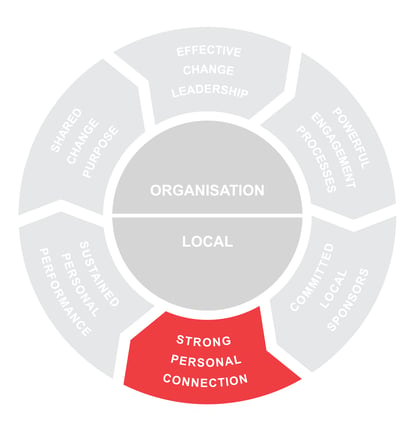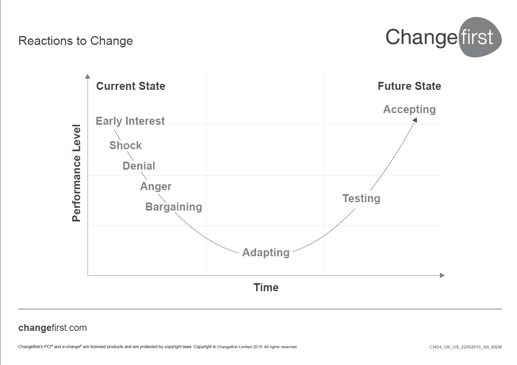The measure of a successful change project is not only having the planned changed implemented but also sustained. Maintaining the organizational, and therefore individual, performance and commitment to change is the key difference between installing and implementing change. Strategic change will only deliver the expected benefits if the people in your organization are supported through the change lifecycle.
Performance is impacted during change
During major change people’s performance drops. Their productivity and work quality is likely to drop because they are going through the various stages of change. They are adapting, or attempting to adapt, to the changes. The individuals themselves may not even be aware that their performance is impacted or that their focus is elsewhere.
This makes it so important that front-line managers and local change agents have the skills to help the people impacted by change to navigate through it. It is certainly important that you are able to train and coach local change sponsors to help their people.

Critical Success Factor 6: Sustained Personal Performance
Strategic change, or any change project for that matter, only becomes implemented when change leaders throughout the organisation pay careful attention to how impacted individuals are reacting to the change.
Many changes fail because people still have concerns, such as whether they will be negatively impacted financially, or if positive work relationships will become fractured. Local sponsors need to identify these concerns and where possible work to minimise them. This is often the point where change projects call for early victory and feel the job is completed. Sustaining commitment to change can be hard work. In our experience, this is the point where we see change projects either being just installed (and not achieving the desired benefits) or implemented.
Maintaining performance through change
Support your local teams during times of change by ensuring your local sponsors are ready to identify and assist individuals who are struggling with the required changes. Your local sponsors should:
- monitor for sustained personal performance
- identify behaviors that indicates a regression of commitment or resistance to the change
- discuss these behaviors effectively and address issues that may be barriers to sustained personal performance
- employ tactics to deal effectively with personal issues around future security, financial impact, work relationships, levels of responsibility and learning curves.
When we approach sustainment of personal commitment to change, then there are 3 key principles we always keep in mind:
- Treat resistance as a natural by-product of organisational change.
- Human reactions to change are normal, so help people understand their own reactions to change.
- You should expect people to go backwards as well as forwards. Change and the stages of change are not linear.

Develop your action plans
Work with your local sponsors to create an action plan that they can use to help sustain performance levels during change:
- Identify teams or groups critical to the change and create a plan for that team/group. Some areas may have more leverage over the success of the change than others. Think through how you can maximize the change effort in these areas.
- Put into place change transition plans for key people. Some people can need quite detailed help when they transition. Organizations often have an organizational plan, but not a personal change plan for individuals.
- Look out for resistance and where necessary encourage it to surface. The most dangerous challenge often comes when resistance goes underground. If you hear negative comments, listen and try and elicit more information and discuss their concerns. Understanding the causes of resistance (whether you personally agree with the viewpoint or not) will help identify how to help people work through that resistance.
- Track where people are on the reactions to change lifecycle. If you know where people are, you can help them to appreciate that their feelings are a normal part of change and move through the process into acceptance. Look for ways to move them on to the next stage wherever you can.
Invest in your local sponsors to deliver local level change
Remember that your local sponsors will also have reactions to change; be aware and ready to support them in the same way.
It is important to remember that the skills needed to implement change can be taught. To achieve each of the local success factors you must focus on involving your local managers early, and giving them the training and access to the right tools and techniques to help implement the planned change.
Incorporate the 6 CSFs into your organizational change management capability
We hope you have enjoyed our focus on the critical success factors for change over the last 2 months. Ensuring your organizational and local-level plans, messages and actions are aligned can be time consuming, but your organization can benefit from implementing a consistent change management methodology and framework which ensures each success factor is considered for all change projects, from enterprise strategic change through to small process change projects.
To find out more about how Changefirst’s industry leading change management framework and platform can help you achieve successful change, read more about it here or contact us to discuss your needs.
Download Our Change Management Methodology White paper.


Leave a comment